Genesis GV60 Vs Volvo C40 Comparison: High-Style EV Face-Off

The EV market is growing at such a pace that automakers can now start exploring niches. The latest examples? The Genesis GV60 and Volvo C40.
Both of these all-electric offerings are ostensibly SUVs, but not really. In operation the GV60, with its wild looks and squat shape, is more of a tall hatchback. Same goes for the Volvo C40; it’s right there in the name, the C prefix traditionally going on coupes and hatchbacks.
Get a Quote on a New Genesis GV60 or Volvo C40Both Genesis and Volvo know the market craves SUVs, though. So unlike our last premium EV comparison, which saw two sedans face off, this one pits two high-style crossovers against one another. Even if they saw just as little time off the tarmac. Managing Editor Mike Schlee joined me to figure out which one is the king of this niche.
Interior and Cargo Space
GV60: Genesis hasn’t toned down its adventurous streak for its debut dedicated electric vehicle. In fact, the GV60 cabin is even more delightfully quirky, from the joystick-grip side-mirror controls to the rotating orb drive selector. We appreciate Genesis keeping the piano black to a minimum too, instead employing a unique textured metallic trim. In fact, you could say touch is the important sense inside the GV60. From the trim, to the quilted leather seats, and the microsuede headliner, the GV60 invites its occupants to reach out and feel something.
The GV60’s fashion-forward status does rob it of some of the usefulness of the C40. There’s not as many useful storage cubbies, for example, and those present aren’t as capacious. That’s about it for our GV60 interior quibbles, however. Everything else is a joy, and fit and finish is amongst the best in the biz.
Up front, the GV60 offers well-designed seats that might not quite match the comfort of the C40’s thrones, but they come darned close. There are handy controls on the passenger seat to allow the driver to easily move the seat forward, as well. Genesis’ Ergo Motion Seat is also standard on this top trim, which inflates individual air cells within the seat to keep fatigue at bay. It also has a stretch mode, but really, we like that the bolsters perform a slight hug whenever we switch into Sport mode. Be warned, tall folks: the GV60 does have nearly two inches less headroom than the more upright C40.
Rear-seat passengers should find the second row a comfortable space. Rear headroom is a decent 38.1 inches (968 millimeters), while legroom is just a half-inch less. Both cars offer heated rear seats, and a pair of USB ports to keep devices topped up.
Trunk space is a reasonable 24.0 cubic feet (680 liters), stretching to 54.7 cu-ft (1,549 L) with the 60/40-folding rear seats down.
C40: By comparison, the C40’s interior is staid, the most surprising feature being the blue that dominates the lower half of the cabin. But this is a Volvo we’re talking about. That cool, slightly aloof Scandinavian style is part of the appeal. The dashboard design is pure XC40, a simple design with four thin, vertical air vents to break up the space. A thin strip of wood with a topographic pattern is a welcome touch.
We like the big door pockets and the built-in trash receptacle within the center console. Less impressive is the thick seam surrounding the plastic bulge holding the climate and audio controls. It looks cheap and feels like a holdover of the dark ’90s era of cabin design. Beyond that however, fit and finish is top-notch.
The C40’s front row is a pretty swell place to watch the miles roll by. In typical Volvo fashion the front seats are super-comfy, with good lower back support and contouring that encourages proper posture.
Given that dramatic roofline, it should come as no surprise that second-row occupants have a little less space to work with. The Volvo has less headroom (36.7 in / 932 mm) and legroom (36.1 in / 917 mm) than the Genesis, but it does have a friendlier door opening. The lower cushion is also less angled, which may be more comfortable for shorter folks.
SEE ALSO: 2023 Genesis Electrified G80 First Drive Review: Goodbye GasMove around back and pop the rakish tailgate for a small-but-square 14.6 cubic feet (413 L) of storage space. The seats fold down for an okay 42.6 cubes (1,206 L), and there is a middle pass-through for long items. There’s also a small frunk that can hold about a cubic foot’s worth of stuff (28 L). Even with that, the Volvo offers less overall storage space.
Bottom Line: The Genesis is more spacious, no doubt about it. Both Schlee and I prefer its cabin design as well, though the anti-minimalist feel may not be to everyone’s tastes.
Tech and Features
GV60: The GV60 has no less than three screens inside, including a pair of 12.3-inch panels atop the dashboard, and a tinier item for the climate controls. The central panel is a pretty typical touchscreen, featuring Genesis’ latest panel-based main menu. It’s easy enough to navigate at first, either via touch or the rotary dial in the center console. Dig into the menus and you’ll find a frankly daunting level of customization, from themes, ambient lighting, drive modes, and even drive sounds. “GV60 sounds are a cool party trick,” says Schlee in his notes. “Useful? No. But my son liked them.”
Similarly, the instrument panel ahead of the driver can be tweaked and tuned for your preferences. There’s also a crisp head-up display that provides important info right in the driver’s field of vision. Added bonus points for the ability to lock the HUD to the memory driver seat setting, so it automatically adjusts with different drivers.
Genesis has loaded up the GV60 as a presentation of all the brand’s cutting-edge tech. Fingerprint scanner? Here. Facial recognition that can replace a key? Yep. Wireless charging? But of course (and in a clever slot, too). Like the Ioniq 5 with which it shares its platform, the GV60’s front seats also almost fully recline if you’re looking to get a power nap in at a charging station. Best to save the full power of the 17-speaker Bang & Olufsen speaker for another time, if that’s the case.
We can’t forget the Genesis’ extensive suite of driver assists, too. In addition to the usual barrage of acronyms, the GV60 includes a 360-degree camera, parking sensors, blind view monitor, and Highway Drive Assist 2. The latter does the full-range adaptive cruise control act, while also adding in driver-actuated lane changes, and will learn (then mimic) your driving style.
C40: The C40 makes use of Volvo’s 9.0-inch portrait-orientation touchscreen, with an accompanying 12.0-inch digital instrument cluster. The Android Auto-based system has quicker responses than the old Sensus setup, and its row-based menu is certainly easy to understand. It’s just … a little boring. At least this one finally has (wired) Apple CarPlay, a feature that took nearly a year to roll out on the new operating system. We also enjoy the Volvo’s built-in range assistant, which puts range anxiety at ease.
While the digital instrument panel is technically customizable, there’s not much you can do beyond a switch from normal to minimalist themes.
Beyond the screens, the Volvo comes well stocked with heated rear seats, a wireless charger, upgraded Harman Kardon sound system, and a clean air filter. It lacks the GV60’s ventilated front seats, however, and unique features like the fingerprint scanner. (Though given the latter has its fair share of detractors, maybe that’s not a bad thing.) We like the power-folding rear headrests, if for no other reason than they improve the atrocious rear visibility.
This is Volvo: of course the C40 comes with a whole bunch of well-judged safety assists. Automated emergency braking, lane-keep assist, parking sensors, blind-spot monitoring with cross-traffic alert—it’s all here. The Volvo might not have as many bonus features with its adaptive cruise control, but we like how smooth it is in operation.
SEE ALSO: 2022 Volvo XC90 T8 Recharge Review: Healthy SmoothieBottom Line: It’s hard to resist the appeal of the GV60 in this category. Some of the features do feel more like gimmicks than genuine benefits—looking at you, face scanner—but what we used often, we enjoyed.
Powertrain, Driving Feel, and Efficiency
GV60: Schlee is a seasoned vet with a solid poker face. So when he gets out of the GV60 with a grin, you know it’s impressed.
Mr. Managing Editor says the GV60 has “a more fun to drive character,” and there will be no arguments from me. The Genesis takes the E-GMP platform and throws a bunch of power at it. Instead of wilting under 483 horsepower and 516 pound-feet, the chassis relishes the opportunity to have some fun. Those figures are only applicable during Boost Mode. Resist the temptation of that electric green button on the steering wheel and you’ve only got 429 hp and 446 lb-ft.
Even in regular mode, the GV60 has a taut, playful ride. Whether it’s cruising or harrying a set of hairpins, there’s a tossability here that isn’t unlike the scruff-of-the-neck feel of Hyundai N cars. The 21-inch wheels don’t enact too strong a ride quality penalty either, though the GV60 is the bouncier car over speedbumps. Steering feel is light, but then again, it is in everything else these days.
There are four levels of regenerative braking. I prefer the highest i-Pedal setting, which enables full one-pedal operation. Mike prefers a lighter setting, but in both cases, we find the brake feel quite natural.
Range is an okay 235 miles (378 km) for the Performance trim, from the same 77.4-kWh battery pack as the other E-GMP cars. We weren’t able do a full range test in either car, but based on energy usage during the week, we’d expect around 215 miles (346 km). The GV60 can be efficient—but it’s so much more fun when it isn’t.
C40: The Volvo C40 comes in just one flavor in North America. Like the GV60, it’s a single-speed, AWD setup. This one pulls from a fractionally larger 78.0-kWh battery pack however, and its two electric motors produce 402 hp and 486 lb-ft of torque.
Without the myriad drive modes and settings to fiddle with, the C40 is easier to get in and go. It’s quick—surprisingly so—and it handles with a calm and composed demeanor. There’s little road noise, and the soft suspension handles bigger bumps better than the GV60. When you want to really have fun, however, the C40 stops shy. It’s not the light-yet-quick steering, nor the firm, progressive brake pedal. The C40 simply feels mature at all times. That’s probably a good thing for most buyers, but we both like the tugging-at-the-leash feel of the GV40 in Boost Mode. Because we’re weirdos.
I’m happy to report the C40 was a much more efficient drive this time around than our first meeting. Officially, the Volvo is good for 226 miles (364 kilometers). Our charge usage throughout the week put it bang-on for that, and slightly more efficient than the GV60.
Bottom Line: The C40 is pure modern Volvo. It’s quiet and composed, yet surprisingly quick. It handles well, and is probably the most fun-to-drive member of the family. But the GV60 is more fun still. It can’t handle speedbumps quite as well, nor can it quite hit its quoted range estimates. We’d sacrifice that little bit of range for the extra smiles the Genesis provides, however.
Genesis GV60 vs Volvo C40: Styling
GV60: The GV60 takes Genesis’ twin-line motif to its weirdest canvas yet. The EV’s diamond grille migrates south, with pointy, bisected LED headlights pushed to the corners of a noticeably pointy beak. There’s a curvy playfulness to the GV60’s shape that is very different from the Hyundai Ioniq 5 and Kia EV6 with which it shares its platform. The lightning-bolt window trim is a not-so-subtle nod to what powers this little package, too. As we’ve come to expect from Genesis, the Korean brand offers the GV60 in a wide palette of fun colors. We love the mint green, but our tester plays it safe in white.
There’s something almost amphibian about the GV60 in person. Both Mike and I are picking up what the Genesis is putting down, but we acknowledge it’s the more divisive design of this duo.
C40: The C40 recipe is easy as pie: take one XC40 Recharge, and starting from the B-pillar and finishing at the taillights, carefully peel off the bodywork in one graceful curve.
We joke, but the simple nature of the C40 works for it. Volvo’s current design language still wows with its quiet sophistication. The redesigned taillights, which artfully wrap up along the sides of the rear glass, look elegant and expensive. The pair of little roof spoilers at either end is a nice touch, too. Throw in those chunky 20-inch wheels and the two-tone bodywork, and the C40 impresses.
Bottom Line: We might prefer the more outre GV60, but your tastes may vary. We also maintain it’s the more divisive design, not to mention color-dependent.
SEE ALSO: Genesis G80 vs BMW 5 Series ComparisonPricing and Value
GV60: Pricing for the GV60 kicks off at $60,385 ($71,000 CAD), including destination. That nets buyers the Advanced model, which features 314 hp instead of the 429 hp of our Performance tester. Spring for that, and you’re looking at $69,385 ($79,000 CAD). In both cases, the only additional costs are premium exterior paints; most of them in the US, and only the matte options in Canada.
The GV60 is currently only available in select states and provinces. That number is growing, however.
C40: As-tested, this C40 rings in at $61,890 ($74,615 CAD), including destination. Volvo only offers the C40 in one twin-motor, AWD configuration, and a choice of three trims Core, Plus, and Ultimate. The only additional cost here? The sweet Fjord Blue paint.
At its base, the C40 can be yours for as little as $57,490 ($61,965 CAD). It is available online through Volvo’s website, as well as at most dealers.
SEE ALSO: Genesis GV70 vs BMW X3 Comparison: Compact Luxury Face-OffBottom Line: No doubt about it, the C40 has the price advantage here. Base-to-base, the C40 also has a sizeable power advantage. As is typically the case for us, our value judgment depends on the country. In the US, where the gap is $7,500, it’s harder to justify the GV60, even if it’s better-equipped and more powerful. In Canada, where the gap is only $4,400 CAD? We’d make the budget work. Well, if you’re even living in an area where the GV60 is available, that is. Advantage: Volvo.
Verdict: Genesis GV60 vs Volvo C40 Comparison
Mike summed it up best at the end of the week: “the Volvo’s main issue is that the GV60 exists.”
The C40 is a very good car. It’s quiet, comfortable, quick, and well-equipped. It’s fancy without being too fancy. The Volvo is more readily available, and at a price that’s easier to swallow, too.
But the GV60 came along shortly after, and redefined a young segment. Its unrelenting new-ageness might turn some folks off, but Genesis has packed a whole bunch of useful and feel-good tech inside this upsized hatchback. That it’s so fun to drive is just the icing on the cake. If you can get your hands on one, this is our pick for dessert.
Become an AutoGuide insider. Get the latest from the automotive world first by subscribing to our newsletter here.

Kyle began his automotive obsession before he even started school, courtesy of a remote control Porsche and various LEGO sets. He later studied advertising and graphic design at Humber College, which led him to writing about cars (both real and digital). He is now a proud member of the Automobile Journalists Association of Canada (AJAC), where he was the Journalist of the Year runner-up for 2021.
More by Kyle Patrick



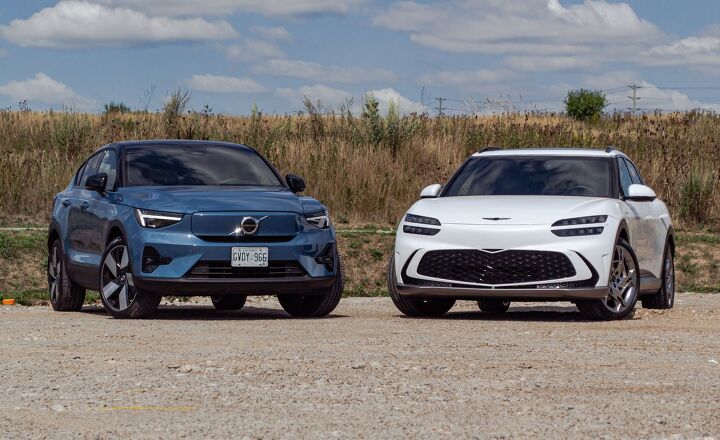

































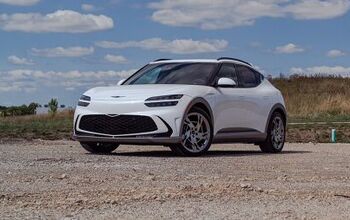


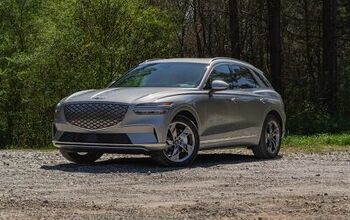
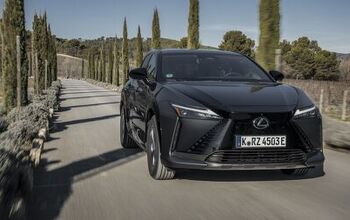


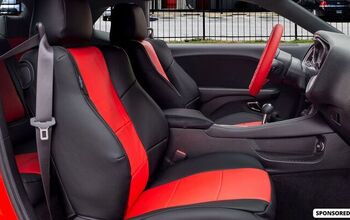

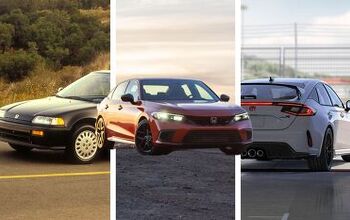



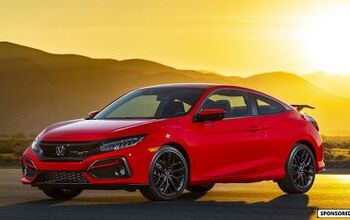

Comments
Join the conversation